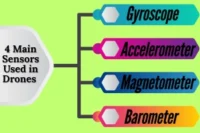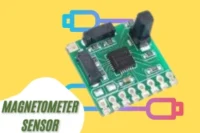Explore the Power of a Drone with Sensor in Action
Published: 2 Aug 2025
Did you know that over 80% of industrial drones now come equipped with sensors? These small devices help drones “see,” “feel,” and respond to their surroundings. Whether it’s avoiding obstacles or detecting heat, a drone with a sensor makes smarter decisions in real time. Industries like farming, construction, and search-and-rescue rely on these advanced features every day. The data collected helps save time, reduce risks, and improve accuracy. If you are planning to use drones for serious work, choosing a drone with a sensor is no longer a luxury—it’s a must. In this blog, we will focus on what drone sensors are, their advantages and disadvantages, and industry-specific uses.
What Are Drone Sensors
Drone sensors are tiny tools that help a drone understand its surroundings. They can detect things like how far something is, if an object is in the way, or even how hot or cold a surface is. These sensors act like the drone’s eyes and ears, helping it fly safely and gather useful information.
Types of Common Drone Sensors
Drones use different types of sensors to do specific jobs. Each sensor has a unique role that helps the drone fly better, stay safe, or collect data.
GPS Sensors : These sensors tell the drone exactly where it is on the map. They help with navigation, auto-return, and creating flight paths for tasks like mapping or delivery.
Obstacle Avoidance Sensors : These sensors use ultrasonic or infrared technology to “see” objects nearby. They help the drone avoid walls, trees, or anything else in its flight path.
Thermal Sensors : These sensors detect heat. They are useful for search and rescue missions, checking solar panels, or finding hot spots in buildings.
LiDAR Sensors : LiDAR (Light Detection and Ranging) uses lasers to measure distance. It creates 3D maps of the ground or buildings, making it great for construction and surveying.
Optical Flow Sensors : These sensors track how the ground or objects below the drone move. They help keep the drone steady, especially when flying indoors or without GPS.
Advantages of Using Drone Sensors
Using a drone with sensors makes flying safer, smarter, and more useful. These sensors help both beginners and professionals do more with less effort.
Improved Safety and Navigation : Sensors help the drone spot trees, buildings, or power lines and avoid them while flying. This means fewer crashes and safer flights, especially in busy or tight spaces.
Accurate Data Collection : Sensor-equipped drones can measure land, inspect rooftops, or monitor crops with great accuracy. They collect the right data without needing extra tools or guesswork.
Automation and Smart Flight : With the help of sensors, drones can follow you, hover steadily, or return to where they started. These smart features make flying hands-free and more reliable.
Time and Cost Savings : Sensors help avoid mistakes like flying in the wrong direction or crashing. This means less rework, fewer repairs, and faster job completion—saving both time and money.
Limitations of Drone Sensors
While drone sensors offer many benefits, they also come with a few downsides. It’s important to understand these limits before choosing a sensor-based drone:
Higher Cost : Drones with advanced sensors usually cost more than basic models. If you only need a drone for fun or casual use, the added features might not be worth the extra price.
Complexity for Beginners : Some sensor-based drones come with settings or features that can feel confusing at first. New users may need a little time to learn how everything works.
Battery Drain : Sensors use extra power during flight. This can reduce the total flight time, especially if the drone has many sensors working at once.
Possible Sensor Errors : In dark areas, rain, or fog, some sensors might not work as expected. This can affect the drone’s ability to detect obstacles or stay steady.
Applications by Industry
A drone with a sensor is not just for flying fun, it’s a powerful tool used across many industries. These sensors help professionals work faster, safer, and smarter.
Smart Farming : In agriculture, drones with sensors check crop health, spray fields evenly, and map large farmlands. This helps farmers save water, reduce waste, and grow better crops.
Construction Work : On building sites, drones help map the area, track progress, and inspect structures. They reach high or risky spots without putting workers in danger.
Emergency Response : During fires, floods, or searches, drones can spot people, detect heat, and assess damage quickly. They help emergency teams act faster and safer.
Nature Monitoring : For environmental work, drones track animals, check forest health, or measure pollution. They collect useful data without disturbing nature.
What to Look for When Choosing a Sensor-Based Drone
Before buying a drone with a sensor, it’s important to think about what you need. Not all drones are built the same.
Purpose of the Drone : Are you flying for fun, work, or a specific job? A hobby drone is simple and affordable, while commercial or industrial drones offer more features for serious tasks like mapping or inspections.
Type of Sensors Needed : Pick sensors based on what you want to do. For example, use obstacle sensors for safe flying, thermal sensors for rescue work, or LiDAR for 3D mapping.
Battery Life and Range : Check how long the drone can fly and how far it can go. Longer battery life and wider range mean you can complete more work in one flight.
Ease of Use and Setup : Choose a drone that’s easy to set up and control, especially if you are a beginner. Look for models with simple apps and auto features like one-click takeoff.
Camera and Storage : Make sure it has a high-quality camera for clear pictures and videos. Also, check if it has enough memory to save your data.
Support and Software : Good brands offer helpful apps, updates, and customer support. This makes it easier to use the drone and fix any problems.
Future of Drone Sensors
Drone sensors are getting better every year. In the future, they’ll make drones smarter, faster, and more useful in everyday life. Here’s what we can expect:
Smarter with AI : Sensors will work with artificial intelligence to help drones make decisions on the spot. For example, they can follow moving objects or change flight paths without help.
Smaller and Lighter : New sensors will be small and light. This means drones will fly longer without using too much battery power.
Better Software Links : Sensors will connect better with apps and tools. This will make it easier to plan flights, manage data, and get useful reports.
New Jobs for Drones : Drones may help with delivery, traffic checks, 3D building scans, and even medical support. Sensors will open the door to more tasks and industries.
Conclusion
Drone sensors have changed the way we fly and work. They help drones avoid crashes, collect better data, and do more jobs with less effort. From farming to filmmaking, a drone with a sensor brings real value.
Before buying, think about what you need. Choose the right sensors, check the features, and pick a model that matches your goal.





